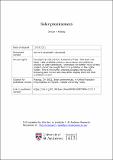Files in this item
Solar prominences
Item metadata
| dc.contributor.author | Mackay, Duncan Hendry | |
| dc.date.accessioned | 2023-02-23T00:36:05Z | |
| dc.date.available | 2023-02-23T00:36:05Z | |
| dc.date.issued | 2021-02-23 | |
| dc.identifier | 270557296 | |
| dc.identifier | 43bd4e41-4f74-4270-a7c4-33036ee9acc3 | |
| dc.identifier.citation | Mackay , D H 2021 , Solar prominences . in Oxford Research Encyclopedia of Physics . Oxford University Press . https://doi.org/10.1093/acrefore/9780190871994.013.17 | en |
| dc.identifier.isbn | 9780190871994 | |
| dc.identifier.other | ORCID: /0000-0001-6065-8531/work/89628014 | |
| dc.identifier.uri | https://hdl.handle.net/10023/27034 | |
| dc.description.abstract | Solar prominences (or filaments) are cool dense regions of plasma that exist within the solar corona. Their existence is due to magnetic fields which support the dense plasma against gravity and insulate it from the surrounding hot coronal plasma. They can be found across all latitudes on the Sun where their physical dimensions span a wide range of sizes (length ~ 60-600 Mm, height ~ 10-100 Mm and width ~ 4-10 Mm). Their lifetime can be as long as a solar rotation (27 days), at the end of which they often erupt to initiate Coronal Mass Ejections. When viewed at the highest spatial resolution, solar prominences are found to be composed of many thin co-aligned threads or vertical sheets. Within these structures, both horizontal and vertical motions of up to 10-20kms-1 are observed, along with a wide variety of oscillations. At the present time, a lack of detailed observations of filament formation gives rise to a wide variety of theoretical models of this process. These models aim to explain both the formation of the prominence’s strongly sheared and highly non-potential magnetic field along with the origin of the dense plasma. Prominences also exhibit a large-scale hemispheric pattern such that “dextral” prominences containing negative magnetic helicity dominate in the northern hemisphere, while “sinistral” prominences containing positive helicity dominate in the south. Understanding this pattern is essential to understanding the build-up and release of free magnetic energy and helicity on the Sun. Future theoretical studies will have to be tightly coordinated with observations conducted at multiple wavelengths (i.e. energy levels) in order to unravel the secrets of these objects. | |
| dc.format.extent | 2254583 | |
| dc.language.iso | eng | |
| dc.publisher | Oxford University Press | |
| dc.relation.ispartof | Oxford Research Encyclopedia of Physics | en |
| dc.subject | Sun | en |
| dc.subject | Prominences | en |
| dc.subject | Filaments | en |
| dc.subject | Filament channel | en |
| dc.subject | Magnetic fields | en |
| dc.subject | Solar corona | en |
| dc.subject | Magnetohydrodynamics | en |
| dc.subject | Solar chromosphere | en |
| dc.subject | QB Astronomy | en |
| dc.subject | QC Physics | en |
| dc.subject | 3rd-DAS | en |
| dc.subject.lcc | QB | en |
| dc.subject.lcc | QC | en |
| dc.title | Solar prominences | en |
| dc.type | Book item | en |
| dc.contributor.sponsor | Science & Technology Facilities Council | en |
| dc.contributor.institution | University of St Andrews. Applied Mathematics | en |
| dc.identifier.doi | https://doi.org/10.1093/acrefore/9780190871994.013.17 | |
| dc.date.embargoedUntil | 2023-02-23 | |
| dc.identifier.grantnumber | ST/S000402/1 | en |
This item appears in the following Collection(s)
Items in the St Andrews Research Repository are protected by copyright, with all rights reserved, unless otherwise indicated.

